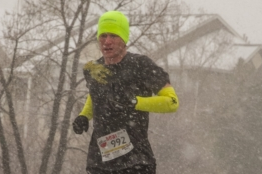One challenging aspect of local races is that while you know the distance and (hopefully) have a reasonably good sense of your ability, the competition around you may be unknown. If you race consistently in an area, it’s likely you’ll start to see familiar faces and know their respective times. Even then, it may not be a given. For example, one runner I know posted a 20-something 5K when we were in the same race a couple of years ago. All of a sudden, he’s now running down in the 18s.
Because of the unknowns of the competition around you, it can also be difficult to know how to race against folks. Are they someone who starts fast, then fades? Do they maintain an even pace? Do they have a solid final kick over the last 1000M or are they more of a runner who sprints the last 200M?
All of that being said, there are certain tactical rules that apply. Assuming you’re running within your time abilities, if there’s someone nearby, then it’s safe to assume you should be smart tactically. In a 5K several years ago, there was a pack of three of us through the whole race, all vying for third place (numbers one and two were too far ahead). I know that I don’t have exceptional sprint speed so if I’m near some other folks in the latter stages of a race and want to make sure I put myself in a good position to finish ahead of them, I may start pushing further out from the finish. In this race, I started my kick with about 1200M to go. It would either work, or the other two would hang with me and outsprint me. Fortunately for me, they weren’t able to hang and I ended up in third.
However, it’s also possible to have tactical missteps, even if you think you’re making a solid decision. In the CMRA Clear Creek 5K race a few weeks ago, after the initial squall of runners at the start, we all settled into our spots. I was in third; fourth was right on my shoulder and he stayed there. (To his credit, when we got to a turn that wasn’t well-marked, he affirmed my decision to go left, the correct direction, when he could have bought himself a few extra seconds by allowing me to go off course.)
Now, generally you don’t want to be the person leading in a situation like this. It takes more energy, especially mentally. Even knowing this, I persisted. Why did I think the rules didn’t apply to me? I was feeling really good, even though my pace was a little faster than planned. Also, I didn’t know this runner on my shoulder. It was possible he was using me as a pacer and was also above his planned speed. Yet, the way he was hanging on made me suspect otherwise and at 1200M to go, my suspicions were confirmed and he threw in a good surge.
We were running along a creek and in the upstream direction. This meant that we were on a very gradual climb and combined with the fact I’d pushed myself beyond my pace, I didn’t have enough in the tank to make a push to reel him back in.
Whether the actual mistake was pushing too hard at the beginning or not dropping back a bit to let him take the lead is hard to say. Even if I had held back a little earlier, I’m not sure I would have caught him. Still, it was a good reminder that even though there are cases where rules can be ignored, they also exist for a reason.
Two of us on the Dry Creek Striders, Collin Knaub and I, ran this race. He won in 17:09 and I got fourth in 19:22. We went to another race last weekend, the 5K In My Shoes, in Evans, Colorado. This one wasn’t timed and there were no awards but if someone was counting, we got first (Collin in 17:10) and I cruised into second place in 19:30. The next DCS race is on 7 May (no firm list of participants yet) and then we’ll do a 10K time trial on 18 May.

Running anecdotes, running food reviews, some race coverage, and more